
James Scott Groenier, MTDC Project Leader, and
Arne "Skip" Rosquist, Hydrologist, Lolo National Forest
The Lolo National Forest asked the Missoula Technology and Development Center (MTDC) for suggestions about mitigating soil compaction at a hot, dry area that was salvage logged during 2004 after a 2003 wildland fire. By 2005, the area had compacted soils, piled wood waste, and very little vegetation (figure 1).
Highlights...
- Soil compaction can occur during fire
activities and salvage logging.
- Hot, dry areas burned by wildland fires
may benefit from a combination of
scarification (loosening of compacted soil)
and application of wood shreddings,
followed by fertilization and seeding.
- This tech tip includes photographs of four sites that were salvage logged at the Lolo National Forest in Montana. Three sites were rehabilitated and one site was not rehabilitated.
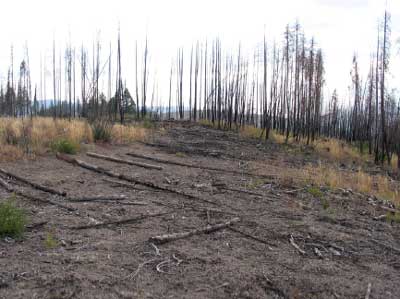
Figure 1—Before rehabilitation, site 1 had compacted soils,
piled wood
waste, and little vegetation.
Logging skid trails and landings were rehabilitated on a portion of the salvage project. Treated sites were on a relatively flat, broad ridge oriented east to west. Soils are volcanic ash-influenced loess (fine, windblown silt) overlaying weakly weathered metasedimentary rocks. The area, which is at 5,400 feet elevation, receives an average of about 40 inches of water per year, primarily as snow. Natural vegetation is mixed forest, dominated by lodgepole pine and western larch.
This project provides a nonscientific assessment for land managers. It shows the results of combining light scarification, shredding, fertilization, and seeding for rehabilitating compacted sites. Controlled scientific studies would be needed to confirm these results.
Rehabilitation MethodsA trackhoe with a slash-buster mechanical head and thumb attachments (figure 2) was used to rehabilitate the sites. The trackhoe was selected because its thumb could scarify the top 3 to 4 inches of compacted soil and spread the woody debris. The trackhoe's slash-buster mechanical head shredded the woody debris. The target shredding coverage rate was about 60 to 70 percent. That coverage would provide adequate cover for erosion control while allowing grass to grow in the openings. After the wood was shredded, the sites were fertilized and seeded with a mixture of grasses.

Figure 2—A Komatsu trackhoe with a slash-buster
mechanical
head and
thumb attachments was
used for rehabilitation.
The decision to use wood shreddings for erosion control was based on the assumption that:
- Woody material was readily available for shredding.
- Wood shreddings provide shade and help keep soil temperatures cooler.
- Shade and cooler soil temperatures help retain soil moisture.
- Wood shreddings prevent the wind from drying out the soil and blowing away seeds.
- Seed germination would increase because of assumptions 3 and 4.
Additional information on wood shreddings and erosion control is available in tech tips by Groenier and others (2005) and Groenier and Showers (2004).
Test sites were photographed before rehabilitation in 2005 (figure 3), after rehabilitation (figure 4), after two growing seasons (2007, figure 5), and after three growing seasons (2008, figure 6).

Figure 3—Site 2
before rehabilitation.

Figure 4—Site 2
after rehabilitation
was complete.

Figure 5—Site 2
after two growing
seasons.

Figure 6—Site 2
after three growing
seasons.
The sites were visited in 2007 and 2008, allowing several growing seasons for vegetation to become established. The results are evident in photographs taken of site 3 (figures 7, 8, and 9) and of site 1 (figures 10, 11, 12, and 13) before and after rehabilitation. Plants did not grow as well in the wheel tracks because compaction was deeper. More scarification would be needed to break up compaction in these places. Some places were covered completely with wood shreddings, which hindered grass growth.
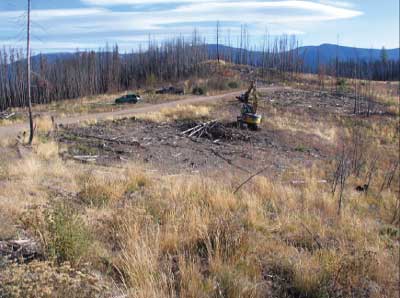
Figure 7—Site 3
before wood
shredding.

Figure 8—Site 3
after two growing
seasons.

Figure 9—Site 3
after three growing
seasons.

Figure 10—Site 1
before rehabilitation.
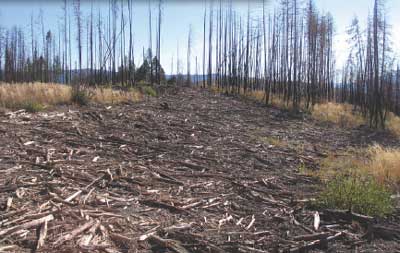
Figure 11—Site 1
after wood shredding
was completed.
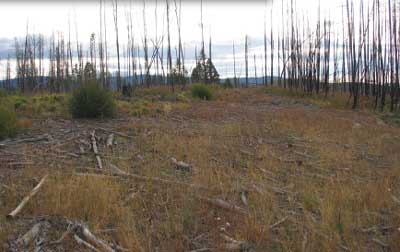
Figure 12—Site 1
after two growing
seasons.

Figure 13—Site 1
after three growing
seasons.
An adjacent site that had burned during the same fire and was logged at the same time was not rehabilitated. That site was photographed in 2008 (figure 14).

Figure 14 – An untreated site adjacent to
the test sites
shows lack of
revegetation
4 years
after salvage logging.
The anecdotal evidence shows that using wood shreddings for controlling erosion and rehabilitating compacted soils shows promise. All compacted areas need to be scarified and protected with wood shreddings for rehabilitation to be fully successful.
ReferencesGroenier, James "Scott"; Foltz, Randy; Showers, Charles 2005. Using rainfall simulators to test wood shreddings for erosion control. Tech Tip 0571–2329–MTDC. Missoula, MT: U.S. Department of Agriculture, Forest Service, Missoula Technology and Development Center. 6 p.
Groenier, James "Scott"; Showers, Charles. 2004. Shredding small trees to create mulch for erosion control. Tech Tip 0471–2335–MTDC. Missoula, MT: U.S. Department of Agriculture, Forest Service, Missoula Technology and Development Center. 6 p.
About the AuthorsJames Scott Groenier began working for MTDC in November 2003 as a civil engineering project leader. Groenier earned a bachelor's degree from the University of Wisconsin at Madison and a master's degree from Montana State University. He worked for the Wisconsin and Illinois State Departments of Transportation before beginning his Forest Service career as the east zone structural engineer for the Eastern Region. Later, he became a civil engineer for the Ashley and Tongass National Forests.
Arne "Skip" Rosquist began working as the forest hydrologist for the Lolo National Forest in 1997. Rosquist received a bachelor's degree in aerospace engineering from Virginia Polytechnic Institute and State University. After spending 5 years in the U.S. Air Force, he earned a master's degree in watershed science from Utah State University. He worked for the Atomic Energy Commission as an environmental engineer and for the Forest Service's Rocky Mountain Region as a water quality hydrologist.
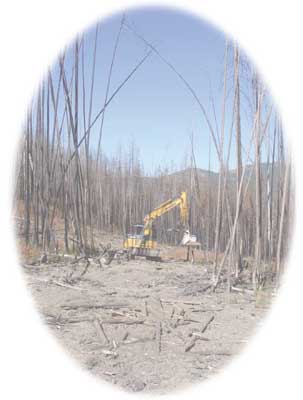
MTDC would like to thank Susan LeVan of the Forest Service's Forest Products Laboratory for funding this project.
Additional single copies of this publication may be ordered from:
USDA Forest Service
Missoula Technology and Development Center
5785 Hwy. 10 West
Missoula, MT 59808–9361
Phone: 406–329–3978
Fax: 406–329–3719
Email: wo_mtdc_pubs@fs.fed.us
Electronic copies of MTDC's publications are available on the Internet at:
Forest Service and Bureau of Land Management employees can search MTDC's documents, CDs, DVDs, and videos on their internal computer networks at:
http://fsweb.mtdc.wo.fs.fed.us/search/
For additional information about Using Scarification, Wood Shreddings, and Seeding To Rehabilitate Disturbed Sites, contact MTDC:
Phone: (406) 329-3900
Fax: 406–329–3719

